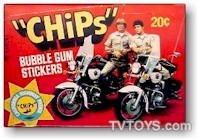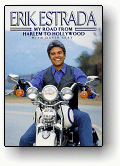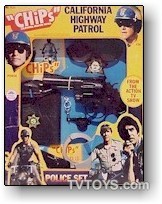 |
As seen in Toy
Trader Magazine
|
 |
| - Published October, 1998 -
|
CHiPs:
The Boys are Back in Town
by Bill D. Morgan and Greg Davis
It’s been 21 years this month since Officers Jon Baker and Frank "Ponch"
Poncherello first patrolled the freeways of Los Angeles on the hit NBC TV show
"CHiPs." The series originally aired on September 15, 1977 and was one of
NBC’s highest rated programs of the ‘70s. During its height of popularity,
"CHiPs" caught the attention of 40% of the viewing audience. With an 8:00 p.m.
time slot on Saturday evenings, it generated a preteen and teen audience that helped
launch the careers of its stars, Larry Wilcox and Erik Estrada. "CHiPs"
consisted of 132 sixty-minute segments and three ninety-minute specials. The adventures of
Ponch and Jon (later replaced by Tom Reilly as Officer Bobby Nelson in the last year)
ended after six seasons.
"CHiPs"
is making its way back to television this year with a reunion movie set to air on
cable’s TNT channel next month. Titled "CHiPs 99," the TV movie will
reunite most of the original characters after a 15 year separation. Scheduled to appear
are Erik Estrada as Ponch, Larry Wilcox as Jon, Robert Pine as Sgt. Joe Getraer, Randi
Oakes as Officer Bonnie Clark, and Bruce Penhall as Cadet Bruce Nelson.
Trading in their Kawasaki 900’s for sporty new BMW motorcycles, Ponch and Jon team
up once again to break up a car-theft ring. The TV-movie is rumored to include the usual
heavy quotient of car crashes and gas-tanker explosions. Filming began back on July 9th
and is scheduled to wrap up in time for an October 27th airdate.
During its original run, "CHiPs" was occasionally interrupted by disputes,
salary or otherwise, between actors Larry Wilcox and Erik Estrada. What began as a
starring vehicle for Wilcox, with Estrada playing his goofy Italian sidekick, ended up as
a more serious action-adventure show with a huge breakout star – Erik Estrada.
Reportedly receiving up to 4,000 fan letters each week, Estrada became a teen idol
sensation while Wilcox faded into the background.
This transformation didn’t occur overnight. The first episode was brutally
criticized by the press, with reviews ranging from bad to worse. The show was heading
toward cancellation by the end of the 10th episode, when the show’s
creator and producer, Rick Rosner, was replaced by a more experienced leader, Cy Chermak.
Chermak brought with him a new team of writers and began making some changes to the
characters, namely Frank Poncherello. Erik Estrada had already begun to receive media
attention, so his character was given a more central role in the series. This put a strain
on the relationship between the two stars that never seemed to repair itself fully.
 NBC’s decision to move the series from Thursday to Saturday night, along with
Chermak’s changes paid off, catapulting "CHiPs" from 57th in the
ratings to rank in the Top 20. It tied with ABC’s "Charlie’s Angels"
for the number 18 spot during its 1979-1980 season. NBC’s decision to move the series from Thursday to Saturday night, along with
Chermak’s changes paid off, catapulting "CHiPs" from 57th in the
ratings to rank in the Top 20. It tied with ABC’s "Charlie’s Angels"
for the number 18 spot during its 1979-1980 season.
Story changes were the first of many blows to the relationship between the lead actors.
After a near-fatal motorcycle accident while filming, Erik Estrada missed a few episodes
during the third season. Reportedly caused by the studio’s hasty decision to have an
inexperienced teamster handle a stunt scene in a getaway car, Estrada’s injuries were
of concern to MGM-TV. In an effort to apologize, the studio surprised him with a brand new
Rolls Royce. The gesture infuriated Wilcox who demanded equal treatment and was soon
reciprocated with a Rolls Royce of his own.
THE CHIPS
WERE DOWN FOR PONCH
Perhaps the biggest blow came when Estrada walked
off the set for several episodes. He was in a dispute with the studio over compensation
for the show’s sale into syndication. Estrada had a 25 percent participation
agreement for anything related to the show, including revenue from its syndication.
Fearing that the studio would find a way to cheat him out of an estimated ten million
dollars, he and his attorneys visited with studio executives to work out a deal. When the
studio made it clear that there was nothing to negotiate at that time, Estrada refused to
show up on the set.
Olympic athlete Bruce Jenner was hired to fill Estrada’s shoes, playing Officer
Steve McLeish for seven episodes during the fifth season. When the show’s ratings
began to plummet, the studio gave in to Estrada’s demands, increasing his $50,000 per
episode fee to $80,000, and paying him a bonus of one million dollars as a good-will
gesture.
Larry Wilcox called it quits after five years. He left the series to concentrate on his
film career that includes: Deadly Lessons (1983); The Dirty Dozen – The Next Mission
(1985); Perry Mason: The Case of the Avenging Ace (1988); Wedding Band (1989); Mission
Manila (1989); and National Lampoon’s Loaded Weapon 1 (1993).
Erik Estrada finished up the sixth season in 22 episodes without his trusted partner.
Tom Reilly was hired as Wilcox’s replacement, playing Officer Bobby Nelson.
"CHiPs" final episode aired on March 20, 1983.
Estrada appeared in a string of films after "CHiPs," including: Light Blast
(1985); Hour of the Assassin( 1986); Alien Seed (1989); The Last Riders (1990); A Show of
Force (1990); Earth Angel (1991); Do or Die (1991); National Lampoon’s Loaded Weapon
1 (1993); The Final Goal (1995); and Visions (1996). A over 30 movies are included in his
filmography.
His latest project, and most notable, was the Spanish soap opera "Dos
Mujeres, Un Camino" translated into "Two Women, One Direction." His
character, Johnny, was originally scheduled to appear in about 100 episodes. From almost
the first day it aired, it was obviously a major hit. Estrada received more fan letters
than his earlier days on "CHiPs," and his 100-episode deal stretched into over
four hundred. The show was the longest-running and highest-rated telenovella in Latin
American history.
His newfound celebrity status South of the Border was enhanced when he won the Best
Actor category in the Latin American equivalent of the Emmy Awards – the Hacé
Awards. Back on top, Estrada decided it was time to put an end to the "bad boy"
rumors that he could never elude in Hollywood after the end of "CHiPs." In his
autobiography "Erik Estrada: My Road from Harlem to Hollywood" in 1997, Estrada
chronicles his life from growing up on the rough streets of New York, details his rise to
superstardom as "Ponch" on American television, and shares his most recent Latin
American success.
HOT WHEELS, HOT
COLLECTIBLES
With early copyright dates of 1977-78 on most of the
memorabilia, it's easy to conclude that manufacturers were eager to get a jump start on
the opportunity to produce official "CHiPs" merchandise and reap the financial
rewards. When the show began in 1977, official licensees included Mego Corp., Placo Toys,
H-G Toys Inc., King-Seeley Thermos Co., Milton Bradley, Fleetwood Toys, and Dargis
Associates, Inc. During the shows subsequent years of production, several other
manufacturers joined the collective mix and added to the existing array of items made. To
date, over 115 different items have been accounted for.
Mego's toy line includes some of the most sought after representations of the boys and
their bikes. Among the first to be released was a line of 3¾" poseable action
figures. Included were a motorcycle, Ponch, Jon, Sarge, and two fictitious villains named
Jimmy Squeeks and Wheels Willy. Each are encapsulated by a clear plastic bubble on 6"
x 9" illustrated cards. Deluxe sets were also packaged with Ponch or Jon figures on a
larger card that included the motorcycle. The deluxe set with a Sarge figure came packaged
with a patrol car in a window display box. Each of these sets are a rare find, costing up
to $75. The single figures usually run about $15-$20 each.
In
conjunction with the 3¾" poseable action figures, Mego released 8" dolls of
Ponch, Jon, and Sarge. Each are packaged in 8½" x 10½" blister cards that
feature several photos of the stars on the front and back. Inside the blister, each doll
is accompanied with an accessories packet containing a helmet, sunglasses and a small
sheet of California Highway Patrol stickers. Notably missing from this line up are the
villains. Mego planned to create a villain named Chopper to coincide with the
"CHiPs" dolls release, but the character was packaged and sold in the
"Starsky and Hutch" doll line instead. Unfortunately for collectors, these dolls
were not designed to last a lifetime. Because of the organic compound used in the plastic,
many of them have discolored over time. It is not uncommon to find a mint-in-package doll
with a green or washed-out face. This phenomenon affects the value greatly. Proper
storage, care, and the avoidance of ultraviolet light can aid greatly in the preservation
of the doll's original appearance. A mint, non-discolored doll is currently valued at over
$50. Notably missing from this line up are the
villains. Mego planned to create a villain named Chopper to coincide with the
"CHiPs" dolls release, but the character was packaged and sold in the
"Starsky and Hutch" doll line instead. Unfortunately for collectors, these dolls
were not designed to last a lifetime. Because of the organic compound used in the plastic,
many of them have discolored over time. It is not uncommon to find a mint-in-package doll
with a green or washed-out face. This phenomenon affects the value greatly. Proper
storage, care, and the avoidance of ultraviolet light can aid greatly in the preservation
of the doll's original appearance. A mint, non-discolored doll is currently valued at over
$50.
In 1980, Mego released a boxed motorcycle scaled to fit the 8" dolls. The lack of
other accessories may have inspired Empire Toys to design two additional items for the
8" dolls in the same year. One was a two-foot long plastic helicopter and the other a
patrol van. The van was also made of plastic and featured sliding doors, each with a photo
sticker of either Ponch or Jon. The box measures a 24" x 8" x 14" and
includes over 20 small accessories made to add to the excitement of play with the dolls.
Although Mego did not create either of these items, most collectors include them in their
doll assembly. Each are valued at $100 when found unused in their boxes, while the Mego
motorcycle sells for about $50.
Empire Toys didn't limit their line to just doll accessories, they also manufactured an
Emergency Medical Kit and child-size motorcycle. The Emergency Medical Kit contains over
25 pieces in a vinyl case. Included is a CHiPs Rescue Safety School Diploma, stethoscope,
eye glasses, microscope, wrist watch, pill box with a photo of the stars, badge, walkie
talkie, and blood pressure gauge with photo. The motorcycle is the largest item in the
entire "CHiPs" collection. It looks something similar to a "Big Wheel"
with pedal action and is constructed to hold a child up to 45 pounds. Size matters with
this item which is partly responsible for its $250 boxed value.
H-G Toys, who made a slew of TV-related puzzles in the 1970s, was not only responsible
for the three boxed "CHiPs" puzzles, but they also produced a few desirable
boxed playsets. Their largest set comes in a 15" x 6" x 16" box and
contains a child-size helmet, 1:1 scale hammer action Magnum gun, holster, handcuffs,
keys, walkie talkies, badge and a pad of play tickets. Constructed from less-than-sturdy
cardboard, the boxes are rarely found in mint condition. Due to is scarcity, however, a
set in average shape will still run over $100. Other sets made by H-G Toys include a
Motorcycle Police Action Set, containing similar contents without a helmet, and another
Police Set that includes a water jet gun.
Ideal was certainly a popular toy company in its time, but was only able to design a
few "CHiPs" items. One was a board game that features a unique illustration of
Ponch and Jon on the box cover. It is a welcome sight to fans and collectors who may have
purchased the previously released board game by Milton Bradley in 1977. The Milton Bradley
version only contains silhouettes of two generic motorcycle cops on the box lid. Ideal's
effort took full advantage of the marketing power of the star's images. The company's
other release was a slot car racing set. Included in the illustrated box are highway
racetracks with motorcycle and van slot cars. Its value is fours times greater the board
games, which sells at about $25 each.
A HIGHWAY OF
TOYS
Some of the last sizable toys in the
"CHiPs" collection come from Placo Toys and Buddy L. Placo made two items, a
plastic bullhorn and a boxed target set game. The bullhorn leaves much to be desired for
collectors as it only contains a small photo sticker on the instrument's side. The target
set, however, features several photos of Ponch and Jon and is packaged in a large,
16½" x 15½" box. Buddy L made several boxed diecast vehicles as well as a Wind
N' Watch Speedster. Buddy L's most enticing release was the diecast gift set that includes
four of the vehicles in a 15" x 4" x 10½" window display box. It sells for
$100, while each individual vehicle will sell for $25 respectively.
Like many other TV-related items from the '70s and '80s, the "CHiPs"
memorabilia line included several items packaged on cards that hung on peg hook display
racks. These "rack toys" were generally made by three prominent manufactures
that included Larami, Imperial Toys, and Fleetwood. Lucky for collectors, all three
obtained a license to produce "CHiPs" toys. Larami seemed to be the least
active, however, with only three different items surfacing at last count. The first was a
vinyl wallet in 1979 that varies in color and sports an illustration of the officers
plastered on the wallet's front. The card features a photo of Ponch and Jon standing by
their bikes with Ponch making a call on his police radio. It's the same photo that was
used for a poster manufactured by Dargis Associates just two years prior. The other two
items made by Larami include a .45 Magnum Target Set and a Book 'em Set in 1983. Each
comes on a unique metallic card the features related police accessories and a colorful
firing target range on the back. A Larami carded toy for "CHiPs" should sell at
$30. The first was a
vinyl wallet in 1979 that varies in color and sports an illustration of the officers
plastered on the wallet's front. The card features a photo of Ponch and Jon standing by
their bikes with Ponch making a call on his police radio. It's the same photo that was
used for a poster manufactured by Dargis Associates just two years prior. The other two
items made by Larami include a .45 Magnum Target Set and a Book 'em Set in 1983. Each
comes on a unique metallic card the features related police accessories and a colorful
firing target range on the back. A Larami carded toy for "CHiPs" should sell at
$30.
The bulk of the other carded toys were made by either Fleetwood or Imperial Toys.
Together they made over 25 different items. Although most of them consist of child-size
police gear, such as sunglasses, badges or handcuff sets, there are a few standouts worth
mentioning. Fleetwood produced a camera that actually takes pictures on 110 film. It's
valued at over $50. Imperial Toys made diecast vehicles that hold much higher values than
the usual plastic toys found on cards. Several different were made that include a
motorcycle, rescue ambulance, helicopter, patrol van, and a 4-wheeler. The set was also
offered in a deluxe window display box and is worth $75-100.
Trying to complete a "CHiPs" collecting may be quite a challenge. These items
are just a drop in the bucket, with dozens of collectibles still left to uncover. Some of
them include: a 26-piece Colorforms playset in 1981; Ben Cooper set out to frighten
trick-or-treaters with an "Officer" Halloween costume in 1978; a plastic
dome-style lunch box arrived in time for lunch in 1977; Revell produced four different
models during 1980-1981; posters of Ponch and Jon as well as several of Erik Estrada were
flying out of poster shops during most of the show's run; the theme to the show was
released in a picture sleeve 45 in 1979 by Windsong Records and was joined by sheet music
from MGM Inc.; and trading cards, toy watches, iron-ons, view-masters and school notebooks
were just a few of the other items that make up this huge, diverse collection. It may seem
overwhelming, but "CHiPs" is one of the most fun and enjoyable collections to
complete.
|
From the publication Toy Trader
|
Greg Davis and Bill D. Morgan are the authors of
Collector’s Guide to TV Toys and Memorabilia — 2nd Edition
Website: TVTOYS.com
Copyright (c) TVTOYS.com, Antique
Trader Publications, Inc. All Rights Reserved. |
|